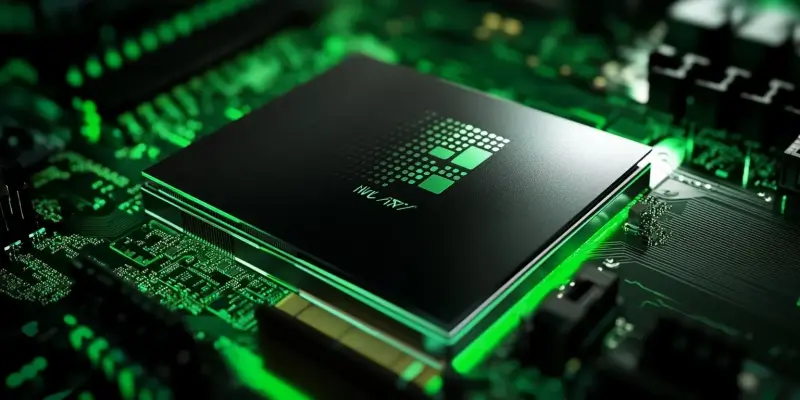Nvidia’s DLSS (Deep Learning Super Sampling) 4 Ray Reconstruction technology is revolutionizing the way ray tracing is implemented in video games. Ray tracing, a technique that enhances lighting realism, often comes at the cost of frames per second (FPS) and introduces issues like noise, surface grain, and loss of texture detail. Nvidia’s latest advancements aim to address these challenges, offering gamers a more stable and detailed visual experience.
The Problems with Ray Tracing Noise
Common Issues with Ray Tracing
Ray tracing has long been hailed for its ability to improve lighting realism in video games. However, this technology is not without its drawbacks. Gamers often encounter noise, surface grain, and heavy denoising, which can lead to a loss of texture quality. These issues compromise the visual quality that ray tracing aims to enhance.
One of the most pervasive problems with standard ray tracing is the introduction of unwanted noise and surface grain. These visual artifacts detract from the immersive experience that gamers seek, creating a distracting and less cohesive visual narrative. Additionally, heavy denoising techniques used to counteract this noise can often blur textures, resulting in a loss of fine details that contribute to realistic environments.
Impact on Visual Realism
The introduction of noise and surface grain can significantly detract from the immersive experience that ray tracing is supposed to provide. Heavy denoising, while necessary to reduce noise, often results in blurred textures and a loss of detail, making the graphics appear less realistic.
This degradation in texture fidelity conflicts with ray tracing’s primary goal: enhancing visual realism. When textures lose their sharpness, and surfaces exhibit graininess, the overall visual experience becomes muddied and less lifelike. As a result, the potential of ray tracing to deliver stunningly realistic graphics is hampered by these inherent issues, prompting the need for more sophisticated solutions.
Introduction to DLSS Ray Reconstruction
Nvidia’s Initial Solution
In 2023, Nvidia launched DLSS Ray Reconstruction as an AI-based denoiser to tackle the issues associated with ray tracing. While this technology offered some improvements, it was not a perfect solution. Noise and loss of detail persisted in many scenarios, leaving room for further enhancement.
The Evolution to DLSS 4
Nvidia’s DLSS 4 represents a significant upgrade over its predecessor. The new version replaces the older convolutional neural network (CNN) with a transformer model. This larger, higher-quality model is designed to improve denoising and enhance the overall visual experience.
The transformer model’s capacity to process more complex data sets and execute more nuanced denoising algorithms has empowered DLSS 4 to significantly cut down on the visual impurities that plagued previous versions. Consequently, gamers can now enjoy more immersive environments with less distracting noise and more vibrant, detailed textures, leading to an overall richer visual experience.
Compatibility and Implementation
Broad Compatibility Across RTX GPUs
One of the standout features of DLSS 4 Ray Reconstruction is its compatibility across all Nvidia RTX GPUs. Unlike Multi Frame Generation, which is exclusive to the GeForce 50 series, DLSS 4 can be utilized on GPUs dating back to the GeForce 20 series. This broad compatibility ensures that a wide range of gamers can benefit from the technology.
Methods of Access
DLSS 4 Ray Reconstruction can be integrated directly into games like Cyberpunk 2077 and Hogwarts Legacy. Additionally, it can be applied to existing DLSS 3 enabled games using Nvidia’s driver override feature. Third-party tools such as DLSS Swapper and DLSS Updater also facilitate the upgrade from DLSS 3 to DLSS 4.
Image Quality Analysis
Comparing DLSS 3.7.20 to DLSS 4
Video comparisons highlighted substantial enhancements in stability and detail retention with the new DLSS 4 version. These improvements are particularly noticeable in games like Star Wars Outlaws and Cyberpunk 2077.
The upgraded transformer model delivers more stable images by reducing the surface boiling effect that was often a mar on otherwise pristine game visuals.
Enhanced Stability and Detail Retention
DLSS 4 Ray Reconstruction significantly improves stability, reducing the surface boiling effect noted in previous versions. The technology also excels in retaining texture detail, addressing one of the most significant drawbacks of earlier versions, which often resulted in blurry or muddy textures.
Improved Motion Clarity and Reduced Artifacts
Better Clarity in Moving Scenes
One of the most substantial benefits of DLSS 4 is its ability to provide better clarity in moving scenes. The new transformer model handles lighting adjustments more adeptly, reducing artifacts like ghosting and providing cleaner, more consistent detail.
Surface Artifacts and Responsiveness
While DLSS 4 makes considerable strides in reducing artifacts and improving responsiveness, it isn’t entirely free from issues. The new model can still introduce strange surface patterns and occasionally degrade texture quality. However, these instances are less frequent compared to previous versions.
Performance Impact and Broader Availability
Performance on Older Architectures
The new transformer model in DLSS 4 is more taxing on GPU performance, especially on older architectures like Turing and Ampere. Despite this, the visual improvements justify the performance costs for many users, making it a worthwhile upgrade.
Encouragement for Game Developers
DLSS 4 Ray Reconstruction tackles these problems head-on, using machine learning to enhance the visual quality without the usual performance hit. By leveraging artificial intelligence, Nvidia’s technology can effectively reduce noise and surface grain, while also preserving intricate texture details that make the virtual world more immersive and lifelike.
For gamers, this means enjoying a much steadier and richly detailed visual experience without sacrificing FPS. The breakthrough also represents a significant leap forward for game developers, enabling them to create more visually stunning worlds without worrying about performance trade-offs. Nvidia’s innovation enhances both the visual fidelity and the playability of modern video games, making it a must-have feature for gaming enthusiasts chasing cutting-edge graphics.
In summary, Nvidia’s DLSS 4 Ray Reconstruction is a game-changer in the realm of video game graphics, solving long-standing challenges of ray tracing and elevating the overall gaming experience to new heights.

